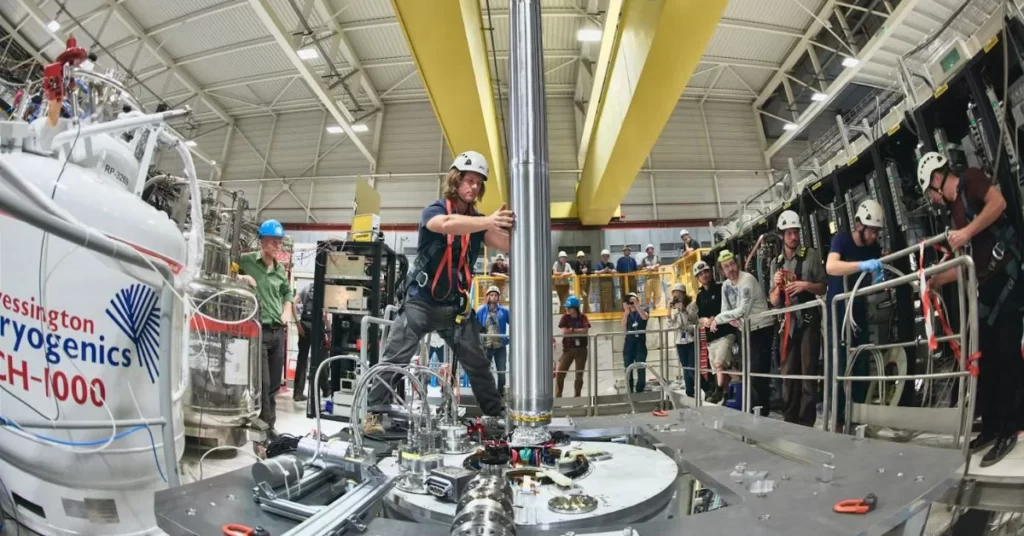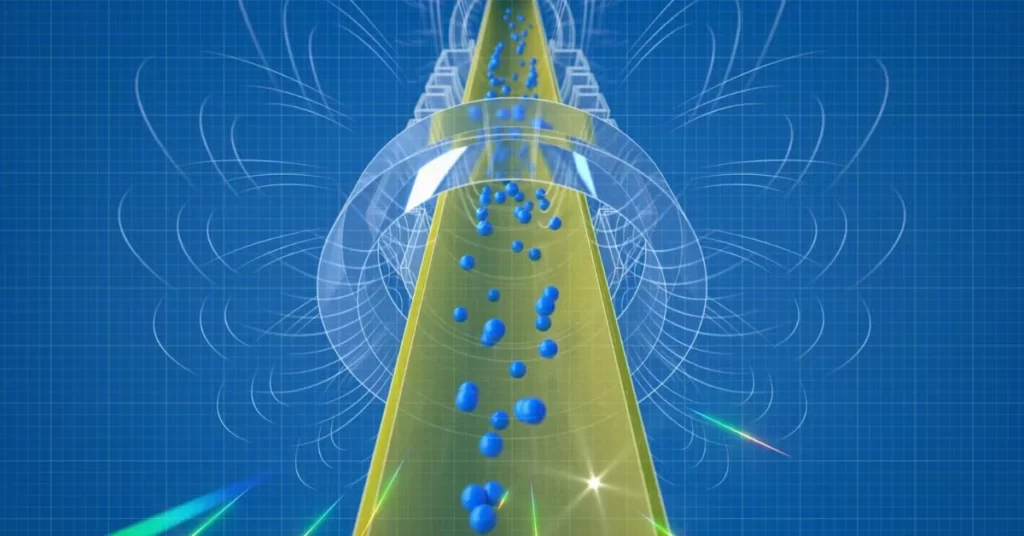The concept of antigravity and using antimatter for things like levitation, perpetual motion machines, or warp drives has often been a popular topic in science fiction and speculative discussions. However, in the realm of real-world physics, these ideas have faced significant challenges and limitations.

Einstein’s theory of general relativity is a fundamental framework for our understanding of gravity and how it affects the fabric of spacetime. It has been extensively tested and confirmed through various experiments and observations.
The recent experiment you mentioned likely reinforces the principles of general relativity, which describe how gravity works in our universe. According to these principles, there is no known mechanism for achieving antigravity, and antimatter, while a fascinating concept, follows the same gravitational laws as ordinary matter.
While it’s disappointing for fans of science fiction, the laws of physics, as we currently understand them, do not allow for some of the exotic concepts seen in shows like Star Trek. However, the pursuit of scientific knowledge and exploration continues, and who knows what new discoveries may lie ahead in the future.
The recent experiment conducted by Emma Anderson and her colleagues at ALPHA is a significant scientific achievement in confirming a fundamental prediction of Albert Einstein’s theory of general relativity. It provides experimental evidence that matter and antimatter experience gravity in the same way, specifically, that they are both attracted to each other by gravity.
This experiment used antihydrogen atoms, which consist of an anti-electron (positron) orbiting an antiproton. By observing how these antihydrogen atoms fell under the influence of Earth’s gravity, the researchers were able to confirm that antimatter responds to gravity just as predicted by general relativity.
This finding has important implications for our understanding of the behavior of antimatter and the fundamental laws of physics. It reaffirms the consistency of general relativity’s predictions with real-world observations and experiments, reinforcing the accuracy of Einstein’s theory in describing the behavior of gravity on a cosmic scale.
While antimatter continues to be a subject of scientific fascination and study, experiments like these help us refine our understanding of its properties and how it interacts with the forces of the universe.
A Gravity-Powered Antimatter Experiment at CERN
In a groundbreaking experiment, Anderson and her team conducted a test with atoms of antihydrogen by dropping them down a tube under the influence of Earth’s gravity. While this may sound simple, it had never been done before. The experiment aimed to determine whether antimatter, in this case, antihydrogen, would behave the same way as ordinary matter when subjected to gravity.

Antihydrogen is created by combining positrons and antiprotons. Antiprotons are generated in high-energy particle collisions and then decelerated at CERN (The European Organization for Nuclear Research), which houses the Large Hadron Collider. Positrons, on the other hand, are produced through the radioactive decay of certain elements.
Working with antimatter presents a unique challenge because it annihilates upon contact with ordinary matter. To prevent this, the researchers used an eight-pole magnet to guide the antihydrogen atoms along magnetic field lines, keeping them away from the container’s walls, where they could interact with regular matter. Some high-energy antihydrogen atoms still had enough speed to escape the magnetic field, but slower ones were effectively trapped inside it. This experiment aimed to confirm whether antimatter experiences gravitational attraction, in line with Einstein’s predictions, or if it exhibited any peculiar behavior such as antigravity.
ALSO READ: James Webb Space Telescope Uncovers Astonishing Discovery: The Enigma of Jupiter Mass Binary Objects
In a groundbreaking experiment, researchers delved into the fascinating world of antimatter. They conducted an experiment that involved capturing antimatter in a tube and then turning it vertically. What they observed was a remarkable interplay between antimatter, gravity, and magnetic fields.
As the researchers turned the tube containing antimatter, they noted that the antimatter atoms moving downward along the magnetic field lines accelerated due to the added gravitational pull. Conversely, the antimatter atoms moving upward slowed down, influenced by Earth’s gravity attempting to draw them downward. While it was impossible to directly observe the antimatter atoms in action, the instruments recorded minute bursts of energy each time an antihydrogen atom, propelled by gravity, gained sufficient velocity to breach the magnetic field at the tube’s bottom and escape. In doing so, it annihilated itself and an atom of regular matter.
Essentially, the experiment involved reducing the current that generates the magnetic field, releasing a cluster of antimatter atoms to interact with gravity. Approximately 80 percent of these anti-hydrogen atoms descended towards Earth, while the remaining 20 percent continued their upward trajectory. This outcome closely resembled what would be expected from a cluster of regular hydrogen atoms navigating within a magnetic field.
The implications of this research hold the promise of unveiling deeper insights into the fundamental forces governing the universe, offering a glimpse into the enigmatic realm of antimatter.

Attraction, Not Repulsion: Antimatter and Gravity’s Uniting Force
In a remarkable revelation, a groundbreaking experiment has provided compelling evidence that matter and antimatter are drawn together by the force of gravity, contrary to any previous notions of repulsion. This profound discovery has reshaped our understanding of the interplay between these enigmatic entities and the fundamental forces governing the universe.
The experiment, conducted by researchers, involved capturing antimatter within a tube and then turning it vertically. Intriguingly, when exposed to Earth’s gravitational pull, both matter and antimatter exhibited an identical response. As a result, it was established that matter and antimatter are mutually attracted to each other through gravity, in the same manner as all other mass in the cosmos.
While physicists had anticipated this outcome, it was imperative to validate this phenomenon through experimentation. The scientific community recognizes the value of conducting experiments to explore potential new insights, even in cases where the expected outcome aligns with existing theories.
Jonathan Wurtele, a coauthor of the study and physicist at the University of California at Berkeley, emphasized the importance of such experiments. He stated that while the result may not have been surprising to physicists, it underscores the significance of exploring the boundaries of knowledge, ensuring that potential new physics is not overlooked due to preconceived notions.
This groundbreaking experiment not only contributes to our understanding of antimatter but also underscores the enduring quest for knowledge in the realm of physics, where even well-established principles are continually tested and scrutinized.
ALSO READ: Revolutionizing Vaccines: Nobel Prize Honors Pioneers of mRNA for COVID
The cosmos is replete with mysteries, and one of the most perplexing enigmas revolves around the conspicuous absence of antimatter in the observable universe, defying a fundamental prediction of Einstein’s theory of general relativity. While antimatter’s properties have been elucidated by scientific experimentation, the elusive nature of this counterpart to matter continues to baffle physicists.
According to general relativity, antimatter and matter should exist in equal proportions. However, in the vast expanse of the observable universe, antimatter is notably scarce. This incongruity raises profound questions about the fate and whereabouts of antimatter in the cosmos.
One prevailing hypothesis posits that in the aftermath of the Big Bang, matter and antimatter underwent a cataclysmic separation, propelling them to the farthest reaches of the universe, with only a sparse scattering of particles serving as remnants of this cosmic rift. Yet, recent experiments, such as the one conducted by Anderson and her colleagues, cast doubt on this theory, revealing that antimatter does not exhibit the behavior necessary for such an event.
Consequently, physicists are left grappling with a profound mystery: What accounts for the conspicuous absence of antimatter in the observable universe? This conundrum serves as a testament to the enduring enigma of the cosmos, highlighting the boundless frontiers of exploration that continue to captivate scientists and ignite their quest for understanding.
While antimatter may not hold the key to levitation or perpetual motion, it undeniably remains an integral piece of the cosmic puzzle, inviting researchers to unravel the secrets of our universe’s intricate fabric.
The Quest to Understand Antimatter Continues – The Mysteries of Gravity and Interaction
In the ongoing quest to unravel the mysteries of antimatter, scientists have taken crucial steps toward understanding its behavior within Earth’s gravitational field. Researchers led by Gabrielse and Anderson, through a series of meticulous experiments, have sought to determine how antimatter responds to gravity’s embrace.
By manipulating the strength of the magnetic field, the scientists orchestrated a comprehensive study, precisely measuring the acceleration of antimatter due to gravity. The results astoundingly revealed that antimatter, much like ordinary matter, experiences an acceleration of approximately 32 feet per second (per second) when subject to Earth’s gravitational pull. This astonishing parallel with ordinary matter’s gravitational behavior reinforces the notion that antimatter and matter are bound by the same cosmic laws.
As the scientific community delves deeper into this enigmatic realm, future endeavors aim to further refine these measurements, scrutinizing the possibility of subtle distinctions in antimatter’s response to gravity. The overarching goal is to affirm that antimatter is governed by gravity in the same manner as its matter counterpart, thus illuminating a fundamental facet of their nature.
ALSO READ: Uncharted UFO Mysteries: Exploring the Ocean Depths in the Search for Extraterrestrial Secrets
Moreover, the investigation extends beyond the realm of gravity. Researchers are embarking on a comprehensive exploration of how antimatter interacts with electromagnetic radiation, specifically probing its absorption, emission, and reflection patterns. These experiments aim to validate Einstein’s predictions, suggesting that anti-hydrogen shares identical light spectrum behaviors with regular hydrogen.
The pursuit of these intricate experiments underscores the relentless dedication of scientists in unraveling the captivating mysteries that shroud antimatter. The quest for knowledge continues, offering tantalizing glimpses into the intricate tapestry of the universe’s fundamental building blocks.
Please note that the information presented here is based on ongoing scientific research and experimentation.









